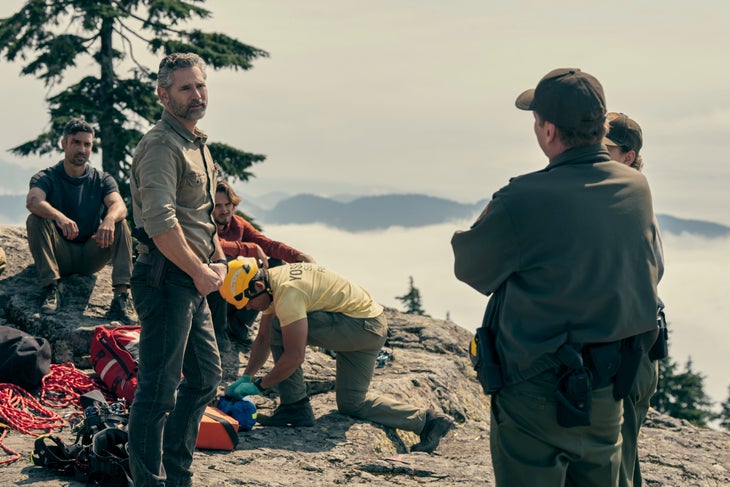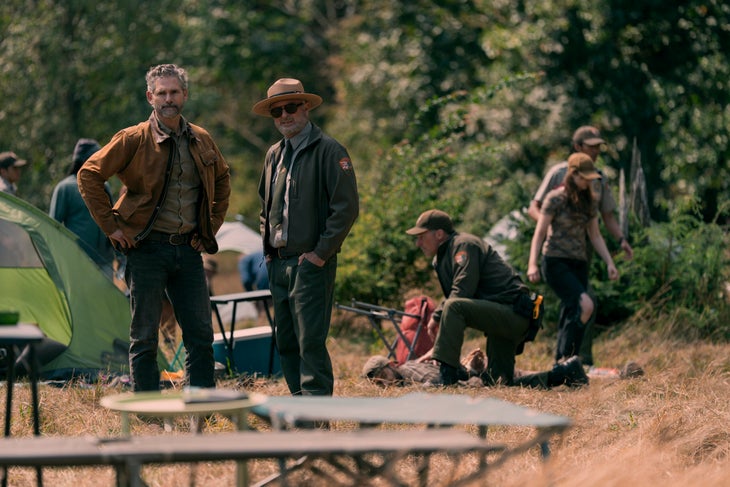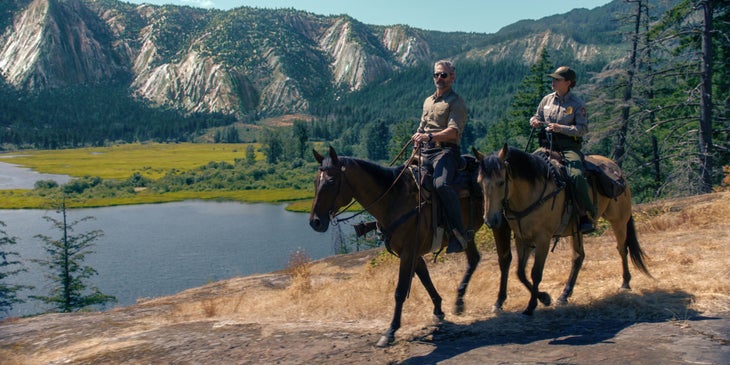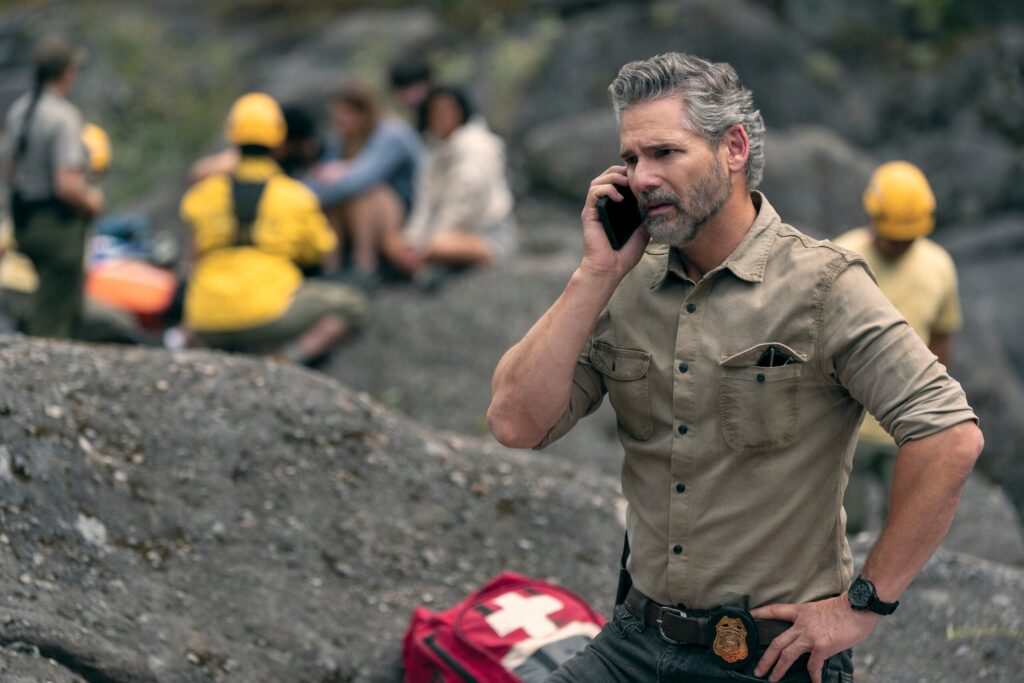Yosemite climbing legend Kate Kelleghan breaks down the national park crime drama’s major discrepancies between TV and reality
Eric Bana stars as a Yosemite National Park special agent in ‘Untamed.’ (Photo: Courtesy of Netflix © 2025)
Published August 20, 2025 04:00AM
If there’s one thing I can say with absolute certainty about Netflix’s new six-episode series Untamed, it’s that they didn’t show enough fat squirrels running around Yosemite.
In Untamed, a federal agent (Eric Bana) and a freshly hired Yosemite ranger (Lily Santiago) investigate a mysterious fatality when a body falls from the top of El Capitan. CGI animals and absurdly unrealistic government-run operations abound as the two explore the overtly non-Yosemite forests searching for answers. They encounter a myriad of challenges, including uncooperative government employees, criminal activity, feisty higher-ups, and their own secrets being exposed as they search for the truth.
As someone who has spent a couple seasons on the Search and Rescue team and the last five years living part time in Yosemite, there were moments I laughed out loud and moments I teared up from missing the lifestyle and beauty of the Valley.
Here’s my honest review, with spoilers ahead.
That Opening Scene? Not Cliffhanger (1993)…But Close.
Untamed’s opening scene had me thinking, This must be what it’s like for doctors to watch Grey’s Anatomy.
Here’s the premise: A climber works his way across a route on El Capitan with a very random assortment of gear on his harness: about five cams, a rack of nuts, and a single sling girth hitched around a gear loop. The belayer hangs from a strange rope anchor connected to bolts, attached by some sort of bowline-hitch knot and locking carabiner on his belay loop.
For some reason, movies always seem to mess up the most basic concept in climbing, which is how we tie in: with a figure eight. Almost every movie with climbing in it features a knot-to-locking-carabiner configuration instead. (Hollywood loves lockers, I guess!) At least they have helmets; unfortunately, the belayer’s helmet hangs unhelpfully on his harness. So close.
The leader asks how much rope he has left. As a climber, this is strange to me: he is only 15 feet away from his belayer and can estimate the rope length by just looking down. The belayer responds, “About 300 feet,” which also makes no sense because 300 feet is at least 70 feet longer than any standard climbing rope.
The leader places a Metolius TCU, an unstable and extremely outdated piece of gear, in a flaring crumbly crack—and skips a nice bolt one foot below for no apparent reason. Nowadays, this type of gear only shows up in your dad’s closet and secondhand stores because newer cams are so much safer and more reliable. Things turn dire when a corpse falls from the summit straight into the lead line and the leader gets ripped off of the wall.
A series of extremely absurd events follows. Several of the bolts that were clipped rip right out of the rock, causing a horrendous fall directly onto the belayer’s device and harness. Ouch. A well-placed bolt in good rock can withstand thousands of pounds of force, about four to five times more than a human fall can generate, so it is incredibly unlikely for a bolt to rip out of the wall, much less multiple bolts. I half expected the anchor to blow up, but it seems that anchor’s stability was necessary to carry the plot forward. Lucky them!
A Rogue Agent Amongst a Rescue Team

The rescue operation is reminiscent of Law and Order crime scenes. Some people wear rescue gear, others wear uniforms, but our main character shows up at the top of the cliff on his steed (yes, a horse) in fashionable, modern clothes. I pondered this. Did he ride the horse all the way up from the Valley floor? That would’ve taken many hours. Or did they hoist the horse up the wall so he could maintain his horseback reputation in front of his colleagues? Either way, he certainly appears stylish.
My confusion deepened when I saw the rescue team using an Arizona Vortex, a specialized piece of rescue equipment for directing a rope over an acute cliff edge that is not part of YOSAR’s rescue kit; almost all of Yosemite’s granite cliffs feature very gradual or rounded edges. When the YOSAR team heads to an incident like this, we have an entire system and process that is highly specific and predictable, prioritizing safety. Every person on scene is in specialized footwear, clothing, and an entire kit of gear ranging from gloves, cordalette, carabiners, pulleys, and capture devices for rescue operations. Every team member works as a part of a whole, redundancy is mandatory, and no one acts as a sole decision maker. On a scene like this, everyone would be in helmets, uniform, and moving quickly.
That is not the case here. Forget safety checks and chain of command. Our hero laughably wears jeans and leather boots as he straps himself into a chest harness with no helmet, gloves, or other equipment and rappels off the cliff alone. Maybe La Sportiva made him some custom, sticky-rubber-and-leather boots?
Does He Even Go Here?
The new park ranger who works alongside this rogue federal agent becomes his right-hand investigator to the suspected foul play throughout the show. But the detective work they embark on is a bit far-fetched from the scope of a new ranger’s involvement regarding crime in the park.

While there are dedicated Investigative Services Branch (ISB) agents in Yosemite, which is not the case for every national park, they most certainly would not show up on a horse. For more serious incidents like drug operation busts or people wielding guns, Special Response Team (SRT) rangers would usually respond. The park might even call in the FBI or National Guard if there was something like a bomb threat. A new ranger would certainly be asking questions and investigating illegal camping, and may get pulled into more serious incidents if the park was shortstaffed, but the likelihood of this specific pairing and the depth of their work together is slim.
The biggest discrepancy is the glaring lack of teamwork, process, or sensible leadership through the whole series. It doesn’t take a lot of research to know this is not the way the government works.
Inconsistent Landmarks
Views of recognizable Yosemite landmarks lead into scenes that are clearly filmed in other parks and even other countries (Netflix shared with Outside the ‘Untamed’ filming locations). The forests they explore do not feature the famous tall sequoias of the valley, and the views show generic mountain ranges instead of the white granite patches and skyline of Yosemite Valley’s surrounding wilderness.
One of the most common pieces of knowledge about Yosemite is how difficult it is to actually camp or spend a night within the park. Camping is extremely limited, and in order to stay outside of designated campground, one needs to go through the system with permission and permits, also scarce and location-limited. Anyone operating outside of these rules will get hassled, ticketed, and evicted eventually.

In the show, we learn that a community of squatters are camped in a random meadow, apparently left alone by the rangers because they “turn up in another part of the park.” Given the park’s strict regulations and zero tolerance policy on camping outside of regulated areas, this lenience is ridiculous. I’ve watched many unlucky campers get booted from their illegal spots throughout the years.
The introduction of the famous Ahwahnee Hotel made me giggle. In contrast to the more rustic and well-worn coziness of the real Ahwahnee, it appears to be a CGI-generated, five-star, rustic-chic establishment. The facade is spotless and modern, the interior is polished, and the furniture and decoration is new and clean.
Most of the infrastructure in the show is obviously not Yosemite, which has a very limited amount of space and housing, and all of it is quite old. Buildings in Yosemite date back to as early as the 1800’s, and most buildings were built likely more than 40-50 years ago. The interior of the police station is certainly not shiny and office-like as is portrayed, but rather fitted for functionality and efficiency in prepping for incidents.
The Lingo is Off
Many of the rangers and SAR employees are so familiar with the formations in the park, using shorthand or acronyms for some of them. If they had scripted “El Capitan” as “El Cap” a few times, that might have given a sliver of authenticity to the dialogue.
Instead our ranger and rogue FBI agent turn full SWAT team and end up on an adventure through nonexistent goldmines in the Yosemite wilderness, dealing with everything from bear attacks to bombs in their quest for the truth. Black bears, the only type of bears in Yosemite, hardly ever attack humans. And if they do, it is usually a last resort. Most bears in Yosemite will amble around looking for food, and run away from any encounter with people.
Things Untamed Did Well
I truly felt the most authentic moment was a character saying “Yeah, [cell] service is pretty bad in the park.” Ain’t that the truth. I’ve spent entire weekends not being able to send a text, as the volume of people downgrades the service to nothing. I would actively have to travel to the few spots around the Yosemite establishments that I know have enough service to load anything on my phone or make a call.
I also appreciated the inclusion of rangers hassling some grungy RV campers. This is a daily occurrence in the Valley, sometimes garnering eyerolls at the strict enforcement but also well-warranted with the insane volume of tourists they handle on a daily basis. The rangers really do hold the masses at bay. Left unchecked, this park would be absolutely destroyed by people trampling, trashing, and recreating in an unsustainable way. This is a sad truth of a resource that has far too much demand.

All this being said, the beautiful panning shots of the waterfalls and meadows actually from Yosemite beckoned me to return. The Valley has a magic about it that draws people back and keeps them there, swirling in the surreal nature that is inhabited by humans but dominated by the wild.
Untamed did get this part right: the park can provide a unique and totally captivating experience. You just have to walk more than 15 feet from your car to find it.
Check out our national parks columnist’s take on the real “Untamed’ Yosemite and its overlooked places that deserve the spotlight.
Kate Kelleghan is a Boulder-based Colorado climber who splits her time between Yosemite’s big walls, Colorado’s front range and backcountry climbing, and European destinations from the Alps to Mediterranean limestone. She worked on the Yosemite Search and Rescue team during the 2023 and 2024 seasons and is most at home on long, committing trad routes around the world.


